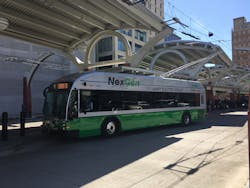Greater Dayton RTA Launches Design for New NexGen Fleet
The Greater Dayton RTA unveiled the design for its NexGen electric trolleys, an update which will be incorporated into the agency’s recent order of 26 of the new dual-mode, battery and electric-wire-powered buses set to hit the streets in early 2019.
The bright green and silver metallic design debuted this week on Bus 1404, one of four prototypes of the NexGen bus that has been in testing with the agency since 2014. The success of that testing led to the decision to purchase 26 new NexGen buses for the fleet. The agency has plans to order an additional 15 NexGen buses soon for a total of 45 of the dual-mode electric trolley buses. This is the largest bus contract in RTA’s history.
“RTA’s NexGen dual-mode electric buses feature a unique, crisp and sleek vehicle design, so we wanted the vehicle colors and any graphics to complement the style of this great looking bus,” said RTA’s CEO Mark Donaghy.
RTA Chief Capital Officer Bob Ruzinsky worked with RTA Graphic Designer Carmen Gaines to incorporate historical bus designs and color combinations used in Dayton over the past 100 years into the new NexGen scheme. The chosen design emulates the classic two-color green and silver combination, which was last used in the 1970’s.
RTA will rebrand the remaining prototype dual-mode electric buses and all future NexGen vehicles with this new design. These buses will replace RTA’s current electric trolley bus fleet, which is 20 years old, and will complement the updated design of the agency’s new diesel buses, which RTA started receiving in 2016.
Each of the electric buses being built will feature its own “fun fact” and will showcase a bit of RTA history as a way to share RTA’s story across the Dayton region.
“Adding the ‘Welcome Aboard fun fact’ to the entry side of each bus is a way to give each bus its own personality,” Ruzinsky said.
Electric trolley buses have a rich history in Dayton. Electricity first started powering public transit in the city in 1888, with streetcars then the main mode of transportation. After a large car barn fire destroyed the majority of the streetcar fleet in 1932, the city began to adopt the “new” technology of electric trolley buses to replace streetcars. In the decades since, Dayton’s transit agencies have continued to operate electric trolley buses and remains today only one of five cities in the nation to do so. The RTA utilizes 124 miles of electric overhead wire infrastructure to power its 7 trolley routes, which provide more than 2 million passenger trips a year. That number is expected grow as the new NexGen buses are received and placed into service.
These “green” electric vehicles both reduce RTA’s carbon footprint and save on fuel costs. Each NexGen electric trolley bus has up to a 20-year life expectancy, compared to a diesel bus’s 12-year expected lifespan.
The NexGens will replace the current fleet of ETI/Skoda electric trolley buses which have been in service in Dayton since 1998. One of the advantages of the NexGen bus is its capability to run off-wire with a Lithium Oxide battery, which can power the bus at 50 mph for up to 15 miles with a full load of passengers. This allows the trolleys to detour around traffic or construction in ways traditional trolleys can’t, as well as allow the RTA to expand traditional trolley routes past the end of existing overhead wire. Another advantage is the ability of coach operators to switch from on-wire to battery mode and return to on-wire operating mode without leaving the bus to rack or reset poles. With these improvements, two routes will be converted from diesel to electric service with delivery of the NexGen fleet and several more will be evaluated for conversion in the coming months.
The Dayton electric buses are also unique in the way they charge their batteries. Other cities who have put battery-powered buses in use in recent years rely primarily on fast-charge stations located along bus routes to charge batteries while the bus remains stationary. RTA’s NexGen fleet will charge while they operate in revenue service on existing overhead electric trolley infrastructure.
“RTA’s objective for this project has been to leverage our existing trolleybus infrastructure investment to expand electric service with a vehicle design that combines the flexibility and efficiency of a standard diesel coach with the advantages of electric propulsion,” Donaghy said. “The NexGen fleet will serve the Dayton Region well for many years to come.”
Customers and the community can see the new design on Bus 1404 which will be used on various RTA trolley routes.
